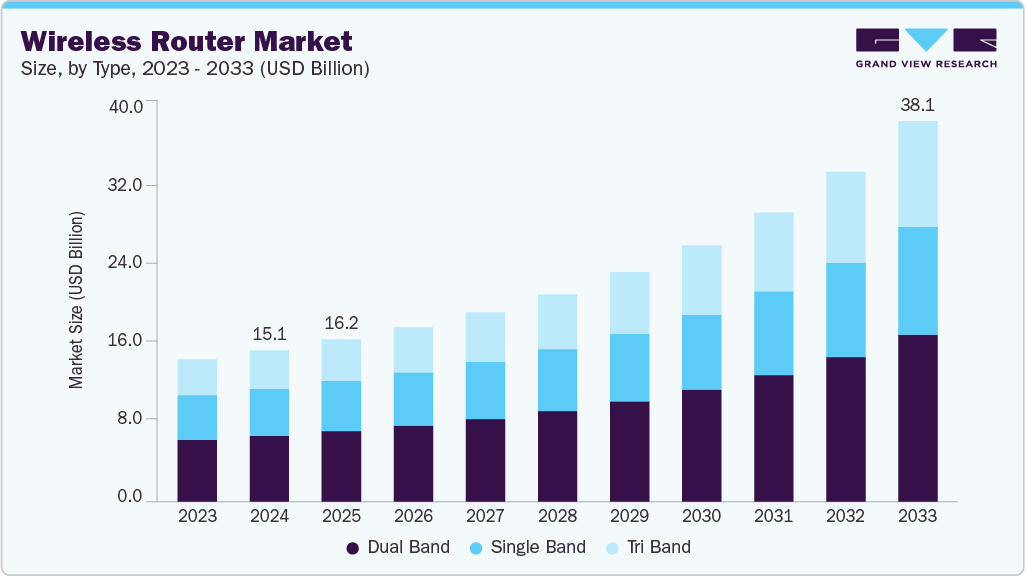Wireless Router Market Size, Share & Trends Analysis growing at a CAGR of 11.3% from 2025 to 2033

The global wireless router market size was estimated at USD 15.19 billion in 2024 and is projected to reach USD 38.10 billion in 2033, growing at a CAGR of 11.3% from 2025 to 2033. The market is experiencing significant growth, driven primarily by the rising demand for high-speed internet connectivity.
Key Market Trends & Insights
- North America dominated the wireless router industry with the largest revenue share of 33.74% in 2024.
- The wireless router market in the U.S. is the largest in North America.
- By type, the dual band segment held the largest revenue share of 43.43% in 2024.
- By bandwidth, the 300 Mbps to 1000 Mbps (1 Gbps) segment held the largest revenue share of 45.12% in 2024.
- By application, the residential segment held the largest life science market revenue share of 52.64% in 2024
Market Size & Forecast
- 2024 Market Size: USD 15.15 Billion
- 2033 Projected Market Size: USD 38.10 Billion
- CAGR (2025-2033): 11.3%
- North America: Largest market in 2024
- Asia Pacific: Fastest growing market
Request a free sample copy or view report summary: https://www.grandviewresearch.com/industry-analysis/wireless-router-market-report/request/rs1
With the increasing popularity of bandwidth-intensive applications such as 4K/8K video streaming, cloud gaming, and video conferencing, consumers and businesses alike require routers that can deliver faster speeds and lower latency.
Another key driver is the rapid growth of smart homes and IoT devices, which rely on stable and efficient Wi-Fi connections. The proliferation of smart speakers, security cameras, thermostats, and other connected devices has increased the need for routers that can manage multiple connections simultaneously without performance degradation. This has led to a surge in demand for Wi-Fi 6 and Wi-Fi 6E routers, which offer improved bandwidth, reduced congestion, and better power efficiency compared to older Wi-Fi 5 models. Furthermore, the upcoming Wi-Fi 7 standard is expected to revolutionize the market with even faster speeds and enhanced reliability, particularly for applications like augmented reality (AR), virtual reality (VR), and real-time cloud computing.
The shift to remote and hybrid work models has also played a crucial role in boosting the wireless router market. With more employees working from home, there is a growing need for reliable home networking solutions that can support video calls, large file transfers, and seamless connectivity across multiple devices. Mesh Wi-Fi systems have gained popularity as they eliminate dead zones in larger homes, ensuring consistent coverage. Enterprises, too, are investing in high-performance routers to support SD-WAN, VoIP, and other business-critical applications. Security concerns are another factor influencing purchasing decisions, with consumers and businesses opting for routers equipped with advanced features like built-in VPNs, AI-based threat detection, and parental controls.





